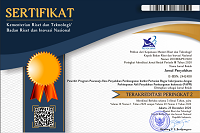ANALISIS SISTEM KELEMBAGAAN DALAM PERENCANAAN DAN STRATEGI PENGELOLAAN LAHAN KRITIS DAS BILA
Keywords:
Institution, planning, watershed, critical land, management
Abstract
The rehabilitation program of critical land had been done since 1985 until 2001, but Bila watershed condition did not get better, even the width of critical land and erotion got more increase. Those were caused by some factors, involved: unaccruracy of technology, limited baudget, and unoptimal institution. Analysis of this study was focused on institution factor. Some of institution aspects that caused failure of rehabilitation of critical land Bila watershed, were is: role of institution sector, performance of management function, weakness on coordination, unrelevant of strategic program, and priority activity. Data collected was conducted by survey on some samples. Interpretative Structural Modelling and Analitycal Hierarchy Process were applied and the result shown that: (1) The main subject in critical land Bila watershed management were institution at regency level, which is Bappeda and Bapedalda, (2) unsuccess of rehabilitation of critical land Bila watershed was caused by planning weakness, (3) top-down policy, one of nine from main factors must be handled for effectiveness of coordination function, (4) to equalize vision and mission Bila watershed management cross territory was one of foor priority strategic frogram in critical land Bila watershed management, (5) and to increase knowledge and farmer skills were one of seven priority activity in critical land Bila watershed management.Downloads
Download data is not yet available.
Published
2007-09-01
How to Cite
NuddinA., SinukabanN., MurtilaksonoK., & AlikodraH. S. (2007). ANALISIS SISTEM KELEMBAGAAN DALAM PERENCANAAN DAN STRATEGI PENGELOLAAN LAHAN KRITIS DAS BILA. Jurnal Penyuluhan, 3(2). https://doi.org/10.25015/penyuluhan.v3i2.2159
Section
Articles
Authors who publish with this journal agree to the following terms:
- Authors retain copyright and grant the journal right of first publication with the work simultaneously licensed under a

This work is licensed under a Creative Commons Attribution 4.0 International License that allows others to share the work with an acknowledgement of the work's authorship and initial publication in this journal. - Authors are able to enter into separate, additional contractual arrangements for the non-exclusive distribution of the journal's published version of the work (e.g., post it to an institutional repository or publish it in a book), with an acknowledgement of its initial publication in this journal.
- Authors are permitted and encouraged to post their work online (e.g., in institutional repositories or on their website) prior to and during the submission process, as it can lead to productive exchanges, as well as earlier and greater citation of published work (See The Effect of Open Access).















